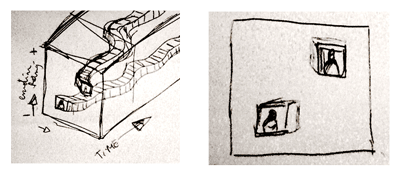How to turn the big idea of yesterday into the focused project of today
The best prototype for a standard is a popular service adopting it
A few years ago, I had a big idea for a new art project involving video interviews.
Ideas can stay ideas for years, and then, they become real project in a few days. I should know, I built events that do exactly that :-)
This summer, I’m participating in the Knight Mozilla Learning Lab. My goal has grown: end the video interviews data obscurity – by building tools to expose (meta)data from video interviews, allowing automated analysis and data-based remix.
You can do it for a series of tweets, for recipes, for Creative Commons licences. But not for a video interview.
I knew I had to iterate, identify the real goal, and build a community. So what’s new? I have a unique opportunity to act, and there is great people that tell great stories giving flesh and blood to those principles.
First I tried to list several problems I though I wanted to solve:
- Find a semantics to use for facial expressions, hand gestures, non-verbal signals
- Decide how data should be linked to specific area on the video
- Balance the level of integration of the toolkit. Is this a popcorn.js plugin? A javascript library? A w3c standard?
- Design a front tool that would use the data to parse, create links, arrange, cluster and compare the video interviews in ways not possible before.
- Integrate series of (maybe long) video interviews as a semantic data sources in apps like Storify or Flipboard.
Once the laundry list of problems is written, it is not helping much.
So I asked a twitter question to both Hadrien Gardeur and Dan Mills: what comes first in a new standard.
Hadrien is cofounder at Feedbooks and was instrumental in building the OPDS standard. Dan is building the new BrowserID standard and tools at Mozilla.
It depends how it all started. For many standards (OAuth or OPDS for example), the use case is already clearly defined
You just have different people solving the same problem differently. In this case, sketching means criticism of existing stuff
The best prototype is to have a popular service adopt the technology (Twitter adopted OAuth early, Fedbooks adopted OPDS)
We’ve been developing use-cases and experimenting for a while, actually. I think we’re on to something this time!
In quest of a nice use case beyond Le Sac à Main, I found that the powerful project It Gets Better could greatly benefit of exposing its video data.
Their website is a collection of (auto)-interviews, but there is no way for a 13 years old to link to stories about bullying at 13, in Arizona, by a shy person – just like him. «What about people like me» is an example of putting things in context.
PS: Focusing on existing use cases is key, but sketching pie in the sky interface like this one :

is fun :-)
